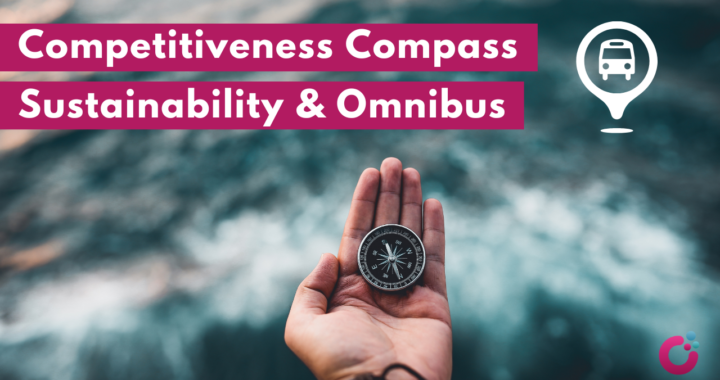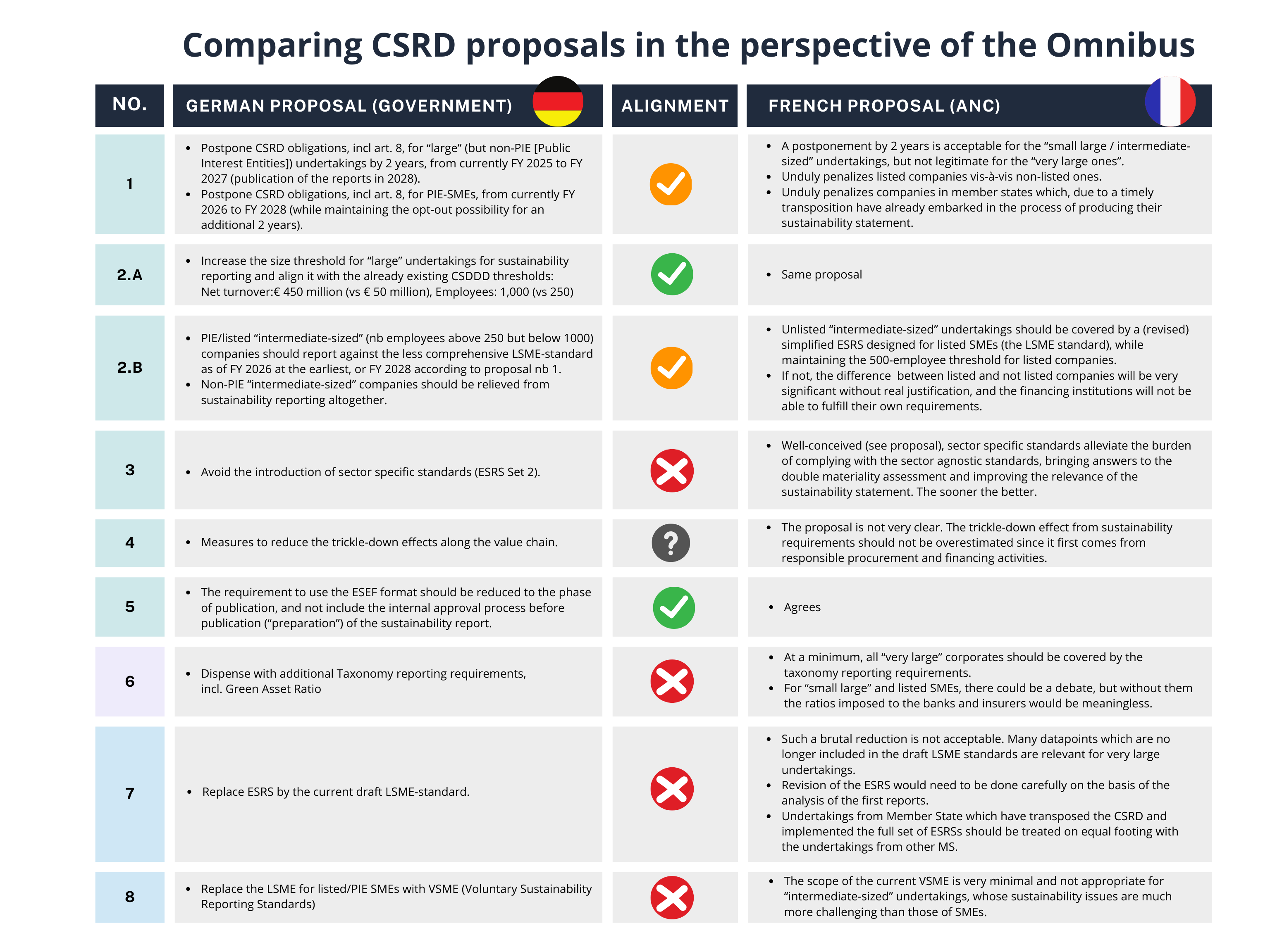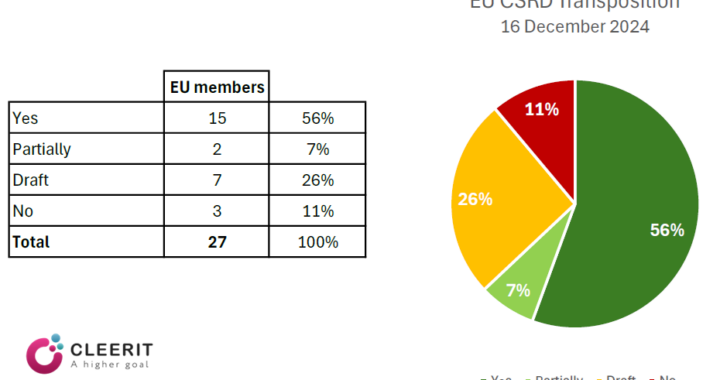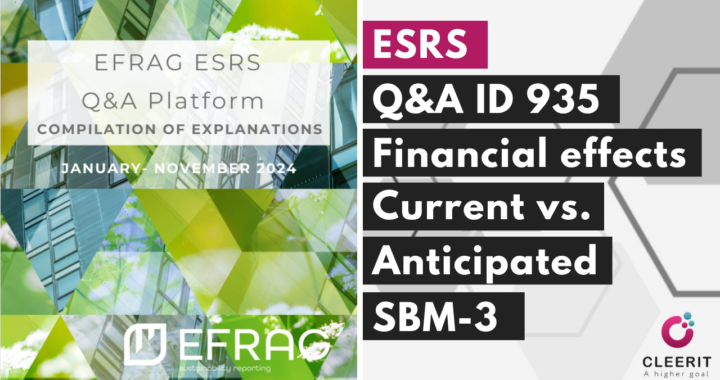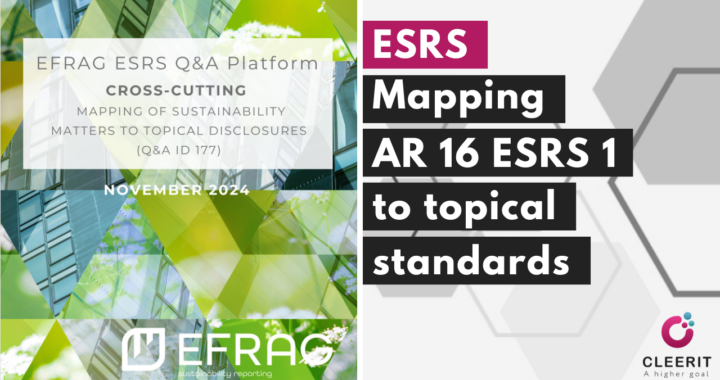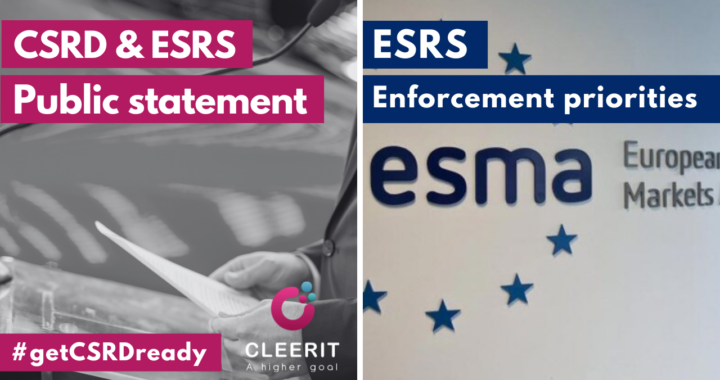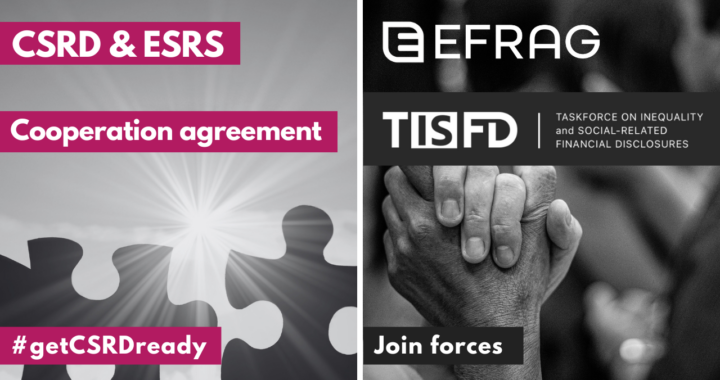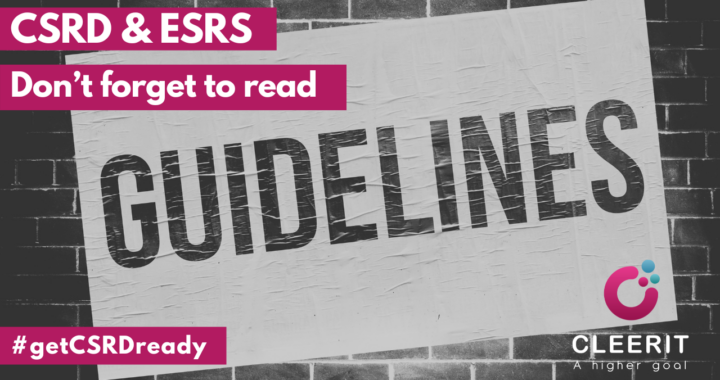On December 6, EFRAG released 64 new Explanations to support preparers and others in the implementation of the ESRS.
EFRAG is considering issuing an additional limited number of Explanations in the course of December 2024. Subsequently, EFRAG plans to release new Explanations in 2025 only after the end of the 2024 sustainability reporting cycle.
The January – November 2024 Compilation can be downloaded here >>>
Included in the November compilation is the mapping of sustainability matters in paragraph AR 16 of ESRS 1 with the Disclosure Requirements in topical standards (ID 177) >>>
Other useful clarifications in the November 2024 compilation include:
Global – instructions
ID 1048 – Disclosure of datapoint(s) related to a non-material Disclosure Requirement for a metric
It is not possible for a datapoint(s) to be material and for the related Disclosure Requirement not to be material when disclosing information on metrics.
However, it may be possible to conclude that an individual datapoint (or datapoints) are not material while the corresponding Disclosure Requirement is material.
Therefore, it is possible for the entity to conclude that not all datapoints need to be provided to fulfill the information requirements for a specific Disclosure Requirement.
ID 526 and ID 1021 – Disclosure of a non-material datapoint … related to a (a) material and (b) non-material topic
Following the provisions in ESRS 1 paragraph 114, in addition to the disclosure of material matters identified during the materiality assessment process, the undertaking may provide additional information stemming from other legislation as well as from generally accepted sustainability reporting standards and frameworks (for example, SASB Standards or GRI Standards).
Other voluntary additional disclosures require the application of professional judgement, are expected to be limited (i.e. disclosure is based on robust reasoning) and shall fulfil the criteria laid out in ESRS 1 Appendix B Qualitative characteristics of information.
This requires that: ‘Complementary information … be provided in a way that avoids obscuring material information.’
For example:
If water consumption is only deemed material in relation to impacts, risks or opportunities that arise in the upstream or downstream value chain and not in own operations, the most relevant metric to be included is the water consumption for the value chain only.
This is not a metric explicitly included in the sector-agnostic ESRS (ESRS E3 paragraph 24 (a) being focused on own operations).
However, even if no datapoint in ESRS E3 is identified as material, the undertaking shall consider whether this or another metric that depicts this matter shall be disclosed as entity-specific disclosure following ESRS 1 paragraph 11.
ID 1297 – Level of disaggregation
The undertaking is expected to report at a legal entity level if for specific matters or material IROs this corresponds to the criteria in ESRS 1 paragraph 54 and 56 (e.g. one legal entity per country and ‘significant variations of material impacts, risks and opportunities across countries’ as well as higher-level aggregation would obscure information).
When needed for a proper understanding of its material impacts, risks and opportunities, the undertaking shall disaggregate the reported information by significant site or by significant asset when material impacts, risks and opportunities are highly dependent on a specific location or asset in accordance with ESRS 1 paragraph 54(b).
Conversely, the undertaking is expected to report information aggregated at group level (or for a cluster of legal entities) if it assesses that a more granular level of disaggregation is not necessary.
In this case, the legal entities/subsidiaries are treated the same irrespective of their location (within the EU or in non-EU territories) when they are included as part of the aggregated data.
ID 1019 – Sustainability matter expected to become material in the future
A matter that is not assessed to be material over the short-, medium- or long-term horizon as of the reporting date, but – if assessed in four to five years – it might become material in the future, is to be considered not-material as the matter is not material as of the reporting date.
ID 923 – Phase-in entity specific disclosure
Entity-specific disclosures are required for the first three years of reporting of sustainability information.
ID 1144 – Phase-in 750 employees: Calculation of average
The ‘average number of employees’ shall be calculated in line with the size criteria as stipulated in the Accounting Directive (Directive 2013/34/EU) Article 3.
The Accounting Directive in Article 3 used the term ‘average number of employees during the financial year’. This is exactly the same term used in ESRS 1 Appendix C, aligning ESRS to the wording and requirement used in the Accounting Directive.
ID 1090 – Length of transitional provisions for early adopters
The voluntary publication of sustainability statements one year earlier than required under the CSRD does not affect the phase-in requirement periods granted by ESRS 1.
Voluntary early application of the ESRS sustainability statement by an undertaking does not count in respect of the years of preparation under ESRS, is not recognised legally, and therefore does not affect the date from when the phase-ins should be calculated.
Accordingly, in the year of mandatory application of ESRS, the undertaking may present its sustainability statement without comparative information in accordance with ESRS 1 paragraph 136 even if it has prepared a voluntary sustainability statement in the preceding year.
ID 1136 – Targets without policy
An undertaking might have a target without establishing a policy on how to get there.
However, this may not be efficient: while a target can be set without a policy, there is no clear management principle, rule or guidance on how to achieve it, making it unlikely to be met.
If the undertaking has a target without a related policy, the description of the relationship of the target to the policy objectives as required by ESRS 2 paragraph 80 (a) shall make that clear.
To note: Minimum Disclosure Requirements – Actions MDR-A – Actions and resources in relation to material sustainability matters also mentions the situation when actions are implemented without a specific policy (see ESRS 2 paragraph 68).
ESRS 2
ID 1072 – DR GOV-1 – ESG expertise of governance bodies
The sustainability-related expertise and skills could be with one person or with more than that from the administrative, management and supervisory bodies or substantiated in another kind of form. ESRS 2 paragraph AR 5 provides further guidance in that respect.
ID 935 – Financial effects – current vs anticipated
Question: what is the difference between current financial effects in ESRS 2 paragraph 48 (d) and anticipated short-term effects in ESRS 2 paragraph 48 (e)?
- Current financial effects are defined as ‘financial effects for the current reporting period that are recognised in the primary financial statements’.
- Anticipated financial effects are defined as ‘financial effects that do not meet the recognition criteria for inclusion in the financial statement line items in the reporting period and that are not captured by the current financial effects’. Anticipated financial effects includes the financial effects that are not ‘current financial effects’.
The second part of ESRS 2 paragraph 48 (d) (second datapoint) requires the disclosure of ‘… the material risks and opportunities for which there is a significant risk of a material adjustment within the next annual reporting period to the carrying amounts of assets and liabilities reported in the related financial statements’.
This datapoint [2.48.d] does not qualify as current financial effects but as anticipated financial effects for which there is a significant risk of a material adjustment within the next annual reporting period.
In this sense, there is an overlap as the datapoint ‘adjustment within the next annual reporting period’ is also part of the anticipated financial effects to be reported under ESRS 2 paragraph 48 (e).
The undertaking may incorporate disclosures using cross-references to the respective parts in the financial statements to avoid repetitions.
Governance
ID 800 – Corruption and Bribery
There is no requirement to distinguish between convictions or fines for corruption and those for bribery in paragraph 24 of ESRS G1.
Additional information about the nature of the conviction or fine is voluntary.
‘Confirmed incidents of corruption/bribery’ is the subject of voluntary disclosures per paragraph 25 of ESRS G1, which requires disclosure of the nature.
There is no concept of ‘incidents of corruption or bribery’ in ESRS.
Social – S1 Own Workforce
ID 271 – Difference between work-related accident and work-related injury
S1.88: A work-related injury is one of the possible consequences of a work-related accident. Work-related incidents that result in work-related injury or ill health are work-related accidents.
Work-related accidents therefore include cases of both work-related injuries, including those resulting in fatalities, and cases of work-related ill health.
Only the cases of work-related ill health that occur as a result of accidents need to be considered.
ID 339 – Use of secondary data, social protection
S1.74: Estimates or secondary data may not be used to determine whether an undertaking’s employees are covered by social protection for this non-quantitative datapoint.
Whether employees are covered by social protection depends on public programs or benefits offered by the undertaking. This information arises from the legal frameworks of the various countries as well as contractual benefits provided by the undertaking to its employees.
Therefore, this information does not relate to quantitative metrics or value chain data, for which the use of estimates may be appropriate.
However, this does not rule out that some interpretation by the reporting undertaking may be needed when compiling the information, for example, when laws about health insurance in a country in which the undertaking operates are not perfectly clear about the kinds of illness that are covered.
ID 430 – Definition of gender
S1.50.a ESRS do not define gender, but they acknowledge the legal existence of three categories: female, male and other.
ID 689 – Gender Pay Gap; Gender + ID 389 – Annual total remuneration ratio and types of workers
S1.97.a: The gender pay gap calculation explicitly requires the inclusion of male and female employees only.
This is a SFDR PAI. There is no mention of ‘other employees’, as defined in ESRS S1 AR 55.
Any contextual information in this regard may be provided according to ESRS S1 paragraph 97 (c), taking into account the general provision in ESRS 1 paragraph 11 in relation to entity-specific information.
ID 453 – Social protection; parental leave
S1.93: Family-related leave is defined as including maternity leave, paternity leave, parental leave and carer’s leave (ESRS S1 paragraph AR 96).
The focus of the Disclosure Requirement is family-related leave covered by regulations (for example, government’s social protection), organisational policies, agreements, contracts or collective agreements (ESRS S1 paragraph AR97) that contain family-related leave entitlements. Such entitlements may differ at a country level.
Being entitled to take family-related leave would thus mean, based on national law or collective agreements, for female employees to be entitled to take maternity, parental and carer’s leave and for male employees to be entitled to paternity, parental and carer’s leave.
The scope of family leave may vary across countries, and such contextual information may be relevant to users (for example, that employees are entitled to maternity leave but not to paternity leave in a given country).
If based on national law or collective agreements female/male employees are not entitled to all the respective female/male types of family-related leave, then they would not qualify to be considered in the nominator of the metric.
ID 550 – Disclosure of discrimination / harassment cases found inconclusive
A company is obliged to disclose a discrimination/harassment case that, upon investigation, was found to lack conclusive evidence supporting the allegations (and hence was considered closed without any supporting evidence).
The total number of incidents of discrimination include all legal actions or complaints registered through a formal process or instances of non-compliance identified through established procedures (for example, grievance mechanisms).
ESRS S1 paragraph AR 103 provides the option to disclose the status of incidents and/or complaints as well as the actions that the undertaking has taken.
To note is that if the incident has been reported in the previous year, it shall not be reported again in the current year.
ID 473 – Restrictions due to national regulations
In some countries (especially outside the EEA), there may be restrictions on data collection of employees. ESRS S1 acknowledges such restrictions for two specific datapoints but not as a general principle; in particular, such provision is in
- ESRS S1 Disclosure Requirement S1-12, on persons with disabilities as well as
- ESRS S1 Disclosure Requirement S1-14 (d)) on work-related ill health and (e) on the days lost to work-related ill health and fatalities from ill health.
For these datapoints, where there is a conflict with national data protection law, it is not necessary to report on the relevant datapoints Contextual information as described in ESRS 1 paragraph AR 76 can be added for more transparency.
ID 730 – Type of employee, social protection
‘Type of employee’ refers to the contract type (ESRS S1 paragraph 50 (b)). This includes permanent employees, temporary employees and non-guaranteed hours employees.
Social – other
ID 1026 – Definition of end-users
If a company sells products B2B, is the potential impact on those individuals to be assessed under S2 or S4?
For example,
A harbor has ferry services and a truck driver who, having to use in their job a ferry to deliver goods, gets injured because of lack of security in the harbor.
Is the impact on that driver to be assessed under S2 (because the truck driver is considered to be a worker in the downstream value chain) or S4 (because the truck driver is considered an end user)?’
ESRS define ‘end users’ as ‘individuals who ultimately use’ a product or service.
This does not include workers of a business customer of the reporting undertaking.
Those workers may use services offered by the undertaking, but they do so in the context of providing a service or producing a good on behalf of their employers.
Typically, such workers should be considered value chain workers.
Environment
ID 968 – Ecolabel
If a company’s metric is verified by an EU Ecolabel, and assuming that the Ecolabel is not an internal body of the undertaking, the Ecolabel can be mentioned as an external body.
According to ESRS 2 paragraph 77 (b), the undertaking is required to disclose whether the measurement of the metric is validated by an external body other than the assurance provider and to specify which body.
CLIMATE (E1)
ID 893 – Conversion factor fossil fuels
Conversion factors for the energy content of fuels (so-called ‘heating’ or ‘calorific values’) need to be used when preparing information on energy consumption. Heating values can be direct or indirect data, originate from multiple sources, and be expressed in different ways (e.g. energy per weight or energy per volume).
Direct data on heating values will result from the analysis of the heat content of fuels used and from which a conversation factor is derived. This is typically done by very large energy consumers (and emitters) who need to know well the fuels they use, for example, power production from fossil fuels.
Indirect data on heating values can comprise, for example, data from fuel suppliers, national statistics data or engineering/technical factors representing usually accepted average figures for each fuel type, often reported as ranges (e.g. biodiesel 39–41 MJ/kg).
Common sources of indirect data for heating values are:
- 2006 IPCC Guidelines for National Greenhouse Gas Inventories (Table 1.2, page 1.18), also used as a reference for Annex VI of the EU ETS Monitoring and reporting regulation;
- the UN Energy Statistics Yearbook, which provides statistical series of Heating values for different fuels and countries (see the supplement to the 2021 Energy Statistics Database);
- GHG national inventories reports (NIR) submitted to the UNFCCC; and publications from energy statistics by the national statistics or energy authorities.
- It is important to note that calorific value changes across jurisdictions.
ID 1126 – Heating values and geographical location of undertaking
According to the ESRS E1 paragraph AR 32, the undertaking is required to disclose quantitative energy-related information in Mega-Watt-hours (MWh) in Lower Heating Value (LHV) (or net calorific value, NCV).
Undertakings that typically use Higher Heating Values (HHVs) (e.g. in certain locations, for certain technologies and/or based on conventions related to energy carriers) must disclose using LHV or net calorific value to comply with the ESRS, which may imply using fuel specific conversion formulas between HHV and LHV.
Note: The LHV (or NCV) of a fuel is the total heat produced by burning it minus the heat needed to evaporate the water present in the fuel or produced during its combustion (see more information on heating values in the background).
POLLUTION (E2)
ID 472 – Major incidents and deposits
E2.40.b: When are incidents and deposits considered to be ‘major’? Is there a qualitative or quantitative threshold to consider?
ESRS do not provide a threshold for distinguishing major incidents and deposits from regular occurrences.
The evaluation of incidents should, in all cases, be based on the undertaking’s materiality assessment and incidents identified as major are likely connected to material impacts and risks and, therefore, likely to be identified as material.
At the same time, incidents of lower scale can carry material impacts or financial risks and, therefore, be assessed by the undertaking as material, too.
ID 1060 – Pollution – affected communities consultations
The undertaking is compliant with ESRS E2 paragraph 11 (b) if it disclosed that it did not conduct a consultation with affected communities. ESRS E2 only requires stating whether the undertaking conducted consultations with affected communities as input for the pollution-related materiality assessment.
If such consultation process was not adopted, the undertaking is to state that fact and, optionally, it can also provide a timeframe in which it expects to have a consultation process in place. Only in the case in which the undertaking did have this consultation process in place will it also need to explain how it consulted the affected communities on pollution-related impacts, risks and opportunities.
ID 619 – Air emissions in ESRS E2 versus ESRS E1
When GHG emissions are material, the undertaking will report them under ESRS E1. If other air emissions (i.e. non-GHG emissions) are material, then the undertaking will need to report those under ESRS E2.
ID 713 and ID 928 – Microplastics – definition and REACH update
E2.28.b The definition of microplastics to use in ESRS reporting is that of the Commission Delegated Regulation (EU) 2023/2772 (Annex II and Disclosure Requirement ESRS E2-4 paragraph AR 20).
The aspects that are key to the ESRS definition of ‘microplastics’ are size (pieces of plastics, usually smaller than 5mm), the intentional or unintentional nature of their generation and impacts on the environment and human health.
Triggering for ESRS reporting are those microplastics that leave the undertaking’s facilities as emissions, products or parts of products or services, which is when the ESRS stipulate that they must be reported by the undertaking if material. Microplastics that leave the facilities as part of products should include those that are released to the environment, either due to wear and tear by product use (e.g. car tires or synthetic textiles) or due to the fact that they were manufactured to be added to products for specific purposes (e.g. exfoliating beads in facial or body scrubs).
It is to be noted that legislation on the matter of microplastics is currently evolving; hence, more defined requirements may be expected in the future.
WATER (E3)
ID 456 – Policies on water treatment
ESRS E3 paragraph 12 (a) (ii) should be read under the assumption that policies on water treatment can promote water reuse as a sustainable source of water. In these terms, water treatment can increase the sustainability of water management practices and, more specifically, water sourcing to the extent that it can reduce the need for water withdrawal and therefore the pressure on the water environment.
It can also improve the quality of water discharges, increasing the availability of high-quality, safe water for withdrawal and ecological functions. The practice can more broadly be seen as an application of circular economy principles to water management.
ID 676 – Water metrics in the value chain
The undertaking can report different metrics for the same sustainability matter for different parts of its value chain based on which metrics are deemed material for its own operations and its value chain.
In relation to the example provided by the submitter, this means that the undertaking would disclose its water consumption in relation to its upstream value chain if material (this would be an entity-specific disclosure when applying sector-agnostic standards), but it would not disclose its water consumption in its own operations if not material.
At the same time, it could disclose water withdrawal for its own operations if material (this is an optional metric) but not disclose this metric in relation to its upstream or downstream value chain if impacts in the value chain are not material.
If only impacts upstream are material, the metric in relation to own operation and downstream value chain are not disclosed.
More specifically, concerning this example the following is to be noted. ESRS E3-4 paragraph 28(a) requires reporting water consumption in the undertaking’s own operations only. If the undertaking deems that this metric is not material for its own operations, it shall not disclose it (see ESRS 1 paragraph 34 (b)).
At the same time, if the metric water consumption is identified as material in the upstream or downstream value chain, the undertaking would be required to disclose it as an entity-specific metric (see ESRS 1 paragraph 11).
ESRS E3-4 paragraph AR 32 provides the option to disclose the metric on the undertaking’s water withdrawal.
Therefore, if the undertaking considers this metric material for its own operation, it may choose to disclose it. At the same time, if this metric is deemed not material for its upstream or downstream value chain, it would not disclose it in connection to the value chain.
BIODIVERSITY (E4)
ID 952 – Metrics – rounding and decimals; materiality of information + ID 953 – Mandatory disclosures of material metrics on Biodiversity
ESRS E4 does not require reporting metrics for each material impact.
For ESRS E4, it is only mandatory for the undertaking to report metrics for ESRS E4 paragraph 35 (if the undertaking identified sites located in or near biodiversity-sensitive areas that it is negatively affecting) and for paragraph 38. In applying paragraphs 35 and 38, the conditions of ESRS 1 paragraph 34 apply.
The disclosure of metrics related to ESRS E4 paragraphs 39, 40 and 41 is voluntary even if the undertaking has identified material impacts in connection with the subtopics mentioned in those paragraphs (the undertaking would still be required to disclose on the other provisions listed in ESRS E4 for those material subtopics).
With regard to ESRS E4 paragraph 38, the undertaking can choose to disclose metrics that measure other or only a few of the aspects listed in that paragraph.
The undertaking shall refer to ESRS 1 paragraph 11 when identifying relevant entity-specific metrics.
Impact metrics in ESRS E4 are rarely standardized. For disclosure requirements where they are not, it is the responsibility of the undertaking to identify the metrics that are relevant to be disclosed (see ESRS 1 paragraph 31 and Appendix B of ESRS 1 for the definition of ‘relevance’).
To assist the undertakings in this process, ESRS E4-5 indicates metrics or indicators that measure relevant aspects related to ecosystems and biodiversity and that may be material for undertakings to disclose.
In relation to paragraphs 39, 40 and 41, reporting on metrics is optional. However, if the undertaking concludes that the inclusion of entity specific metric(s) is necessary (ESRS 1 paragraph 11), the provisions in these paragraphs support the identification of relevant metrics to be reported.
See also Question ID 526 and ID 1021 – Disclosure of a non-material datapoint (water consumption in own operations) related to a (a) material and (b) non-material topic.
ID 1115 – Disclosing the number and area of sites near or in biodiversity-sensitive areas + ID 1172 – Disclosure of the area of sites in or near biodiversity-sensitive area
The undertaking concludes that it is not negatively affecting biodiversity-sensitive areas in or near sites that it owns, leases or manages, it shall not disclose the number and area of those sites (in relation to ESRS E4 paragraph 35).
The undertaking, however, must always disclose whether it has sites located in or near biodiversity-sensitive areas and whether activities related to these sites negatively affect these areas under ESRS E4 paragraph 19 (a).
This disclosure is related to ESRS 2 IRO-1 and, therefore, this information needs to be disclosed irrespective of the outcome of the undertaking’s materiality assessment considering relevance of information (see ESRS 1 paragraphs 29 and 31).
E4.35: The undertaking is required to disclose the total area (in hectares) of a site owned, leased or managed in or near protected areas or key biodiversity areas if it has activities related to these sites that are negatively affecting a biodiversity-sensitive area.
The disclosure refers to the total area of the site, not just the portion that may fall within or be adjacent to the biodiversity-sensitive area.
Information on the total size of a site can be relevant to assess the undertaking’s actual and potential impacts, as activities carried out in the site beyond the immediately adjacent or overlapping portions of a site can still affect biodiversity-sensitive areas nearby.
What to consider as ‘near’ depends on the type of impact that the company has on the biodiversity-sensitive area. It could, for example, depend on the type and amount of pollutant emitted by the undertaking and whether it is transported by water flows (e.g. rivers), ground water or air currents, potentially impacting aquatic and terrestrial ecosystems kilometers away from the pollution source.
WASTE (E5)
ID 283 – Is waste incineration a disposal operation
E5.37 Incineration is to be treated as a recovery operation if it meets the conditions to be considered as an ‘R1 Use principally as fuel or other means to generate energy’ operation, according to Annex II of the Waste Framework Directive. In this case, it is considered as an ‘other energy recovery’ under ESRS E5 paragraph 37(b)(iii).
If the conditions in which incineration occurs are conducive to its classification as a ‘D10 incineration on land’ operation (Annex II of the Waste Framework Directive), then it shall be classified as a disposal operation.
ID 400 – Recycled waste
E5.37 Undertakings can assume that recycled waste can be calculated by subtracting non-recycled waste from total waste provided that they consider all proper components in the equation of the total waste (in order to understand what can be considered as ‘non-recycled waste’) and provided that they know all components except the one of recycled waste.
As per the Waste Framework Directive (WFD), these are the components that need to be considered in the equation of the total waste generated:
- Total waste = recycled waste + reused waste + other recovery + disposed waste.
The above categories are to be understood as per definitions in the WFD:
- Recycled waste: any recovery operation by which waste materials are reprocessed into products, materials or substances. This includes the reprocessing of organic material but excludes energy recovery and reprocessing into materials used as fuels.
- Reused waste: involves checking, cleaning or repairing recovery operations by which products or components of products that have become waste are prepared to be re-used without other pre-processing.
- Other recovery: any waste-recovery operation that serves a useful purpose by replacing other materials. Notably, it includes energy recovery (e.g. incineration with energy recovery).
- Disposed waste: waste that is not recovered (recycled or otherwise diverted from disposal) and is sent to landfill or other disposal methods.
Nevertheless, given the equation, a missing component can be derived if the other components in the equation are known.
To calculate recycled waste, if this component is not known and all others are, undertakings would have to use the following equation:
- Recycled waste = total waste – (reused waste + other recovery + disposed waste)
ID 408 – Categorisation of waste streams
Could you clarify the categorisation of the following waste streams (whether under ESRS E5 paragraph 37 (b) (iii), (c) (ii) or (c) (iii))?
Composting of organic waste, fermentation of organic waste and incineration of waste that results in energy production (which then is used/sold).
Composting and fermentation of organic wastes are considered a form of recycling – see Directive 2008/98/EC of the European Parliament and of the Council (Waste Framework Directive, WFD), Annex II, ‘R3 Recycling/reclamation of organic substances which are not used as solvents (including composting and other biological transformation processes)’ – and a recovery operation for the purposes of ESRS 5 paragraph 37 (b) (ii).
According to Annex l of the WFD, incineration without energy recovery is considered a disposal operation (included as ‘D10 Incineration on land’) and is classified under ESRS E5 paragraph 37 (c) (i) Annex ll of the WFD, which sets out the different types of recovery operations. Incineration with energy recovery is considered disposal if the criteria is not met (as explained in the footnote to R1 of Annex ll, of the WFD) and is to be classified under the ‘R1 Use principally as a fuel or other means to generate energy’ operation.
If classified as an ‘R1 Use principally as a fuel or other means to generate energy’ operation, incineration with energy recovery can be considered under ESRS E5 paragraph 38(b)(iii) as ‘other recovery operations’.
Source: https://www.efrag.org/en/news-and-calendar/news/efrag-esrs-qa-platform-64-new-explanations-available-updating-the-compilation-of-explanations-to-a
—
Stay tuned for more CSRD and ESRS insights.
✅ Adopt a streamlined, digital and taxonomy-centric ESRS report preparation with www.cleeritesg.com
#getCSRDready, #CSRD, #ESRS, #CSDDD, #ESG, #Strategy, #Governance, #SustainabilityReporting, #Digitalisation, #CleeritESG
